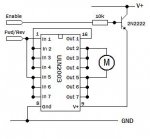I was needing an h-bridge so I could reverse the direction of a Solarbotics GM3 motor. I was going to order a 293D but thought about using a ULN2003 like I've used for small unipolar stepper motors.
Would you take a look at the attached schematic? Surely it can't be that easy. The GM3 at stall draws 600mA so two outputs would be enough but why not hook up the rest of the pins too?
Any body tried this? I can't find my chips (cleaned out the spare room for guests and now can't find them) or I'd just breadboard it and see if any blue smoke comes out.
Thanks for any help.
Arvin
Would you take a look at the attached schematic? Surely it can't be that easy. The GM3 at stall draws 600mA so two outputs would be enough but why not hook up the rest of the pins too?
Any body tried this? I can't find my chips (cleaned out the spare room for guests and now can't find them) or I'd just breadboard it and see if any blue smoke comes out.
Thanks for any help.
Arvin
Attachments
-
14 KB Views: 76

